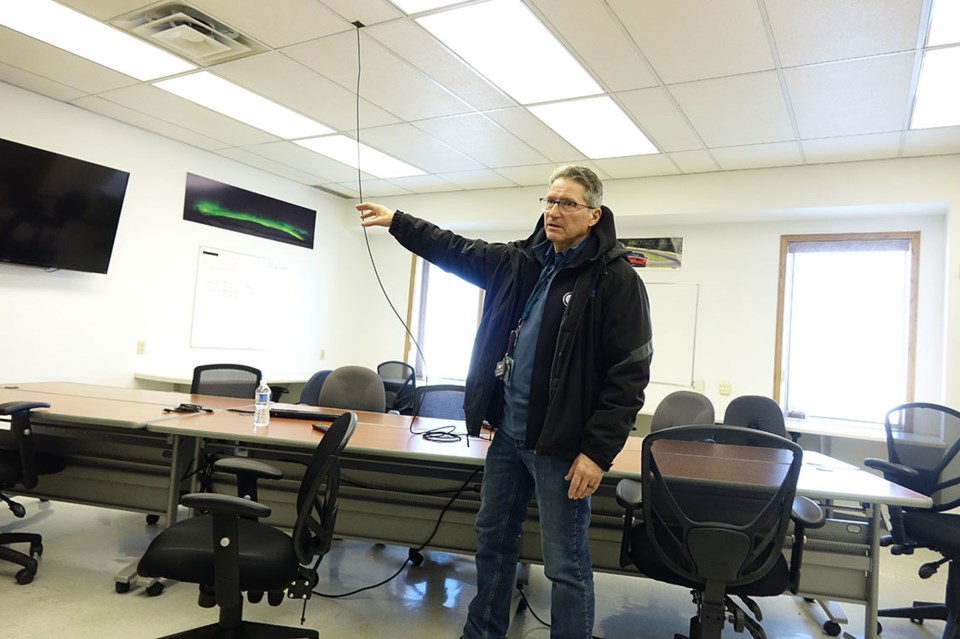The Thompson Regional Airport Authority’s acquisition of the former Ford winter testing centre adjacent to the terminal happened quickly as a result of dominoes falling into place, says airport CEO Curtis Ross.
“Ford decided that instead of owning facilities to lease facilities, so that was our opportunity to jump in and take it on,” Ross said Jan. 24.
Ross’s comments were made as he gave a tour of the Thompson winter weather testing campus after Transport Canada’s Innovation Centre and SubZero North, which facilitates and promotes such testing in Thompson, signed a memorandum at the site, occupied at the time by a number of Honda vehicles that company engineers are testing.
The facility’s main building, a former Keewatin Air medevac hangar, is also known by another name — Area 55 — both a nod to the centre’s location north of the 55th parallel and an allusion to the much more famous Area 51 in the United States.
“We do some unique things here. We do some private things here. But we also do some things we boast,” said Ross, who served for a long time as Honda’s local contact and space provider for winter weather testing. Area 55, he says, is a step up from what he was able to offer.
“We brought them into this and their eyes just lit up,” he says.
Although the airport now owns the winter weather campus, which includes a cold chamber that can be divided into four separate areas that can be set to different temperatures, it isn’t really in a position to market and promote the facilities on offer, which is why the existence of SubZero North is so important to its success.
“We're in the business of running the airport,” he said. “We have the facilities, we want to promote the facilities. We don't have the time to go from our airport and promote winter weather testing. We see SubZero as that arm that can promote for us. SubZero can be that conduit for us, we can participate as a partner in that and make sure that it survives and works.”
Being owned and operated by third-party service and facility provider, rather than a company that only tests its own products there, opens the door to more winter testing.
“For the longest time Ford had this facility tied up and they only come in three, four weeks a year,” Ross said. “We said it was such a waste because we had so many other people that can use it.”
Originally purchased and established in order to make testing large vehicles like the Ford F250 pickup truck possible — before that engineers were testing them in trailers, which weren’t wide enough to accommodate the opening of vehicle doors — the winter weather campus is equipped with 13 hoists that can lift from 7,000 to 12,000 pounds, a fuelling station that enables engineers to quickly swap fuels, electric vehicle chargers, boardrooms and other workspaces, as well as a kitchen.
With Ford deciding that it’s more economical to rent facilities than to own and maintain its own and with the Kelleher family, which owns the Ford dealership in Thompson, wanting to concentrate on the sales and service of vehicles as it undergoes a massive expansion, the airport authority was able to buy the winter weather testing campus for $2 million, much less than it would probably cost to buy a similar facility or establish one from the ground up.
The airport had looked at the idea of purchasing the testing centre before without success so Ross said he was ready when the opportunity came up last year.
“It wasn’t a hard decision when he said, ‘Do you still want to buy it?’” Ross recalled. “It was really easy to get it done. Sometimes the dominoes just happen to fall in the right place.”
Plans for the facility include connecting it to the airport’s water treatment plant so it has potable water and eventually upgrading the refrigeration equipment in the cold chamber, as well as having two employees to staff the facility. Given the harsh winter conditions that vehicle testers can sometimes be out in, Ford always provided them with a winter survival kit and radios and recorded their route, destination and itinerary so if anyone was overdue returning, someone would notice right away and, if a search was ever needed, they would know where to look.
In addition to providing a winter weather testing base, the campus can also serve as a storage and maintenance spot for airport vehicles and equipment. There’s also the possibility of using the cold chamber for more than just engine testing.
“In the summertime we can use that as a freezer, or in the fall or the spring,” said Ross, if a person, organization or business needs to keep cargo frozen before it sets out for its final destination.
On top of providing the privacy that vehicle engineers need to perform their testing, the campus also comes with a view.
‘They get to see the planes take off and leave,” Ross says. “It’s a nice vista for them.”
Having a facility to offer to parties interested in testing vehicles and other products in Northern Manitoba also helps make it clear to new clients that winter weather testing is well established in Thompson and will be around for years to come.
“It’s solidifying to them that we’re growing the industry and we’re trying to evolve in the long term,” Ross said.




